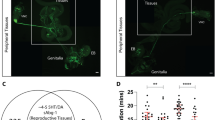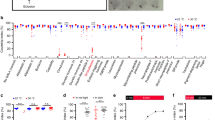Abstract
Throughout the animal kingdom the innate nature of basic behaviour routines suggests that the underlying neuronal substrates necessary for their execution are genetically determined and developmentally programmed1,2. Complex innate behaviours require proper timing and ordering of individual component behaviours. In Drosophila melanogaster, analyses of combinations of mutations of the fruitless (fru) gene have shown that male-specific isoforms (FruM) of the Fru transcription factor are necessary for proper execution of all steps of the innate courtship ritual3,4,5,6,7,8,9. Here, we eliminate FruM expression in one group of about 60 neurons in the Drosophila central nervous system and observe severely contracted courtship behaviour, including rapid courtship initiation, absence of orienting and tapping, and the simultaneous occurrence of wing vibration, licking and attempted copulation. Our results identify a small group of median bundle neurons, that in wild-type Drosophila appropriately trigger the sequential execution of the component behaviours that constitute the Drosophila courtship ritual.
This is a preview of subscription content, access via your institution
Access options
Subscribe to this journal
Receive 51 print issues and online access
$199.00 per year
only $3.90 per issue
Buy this article
- Purchase on Springer Link
- Instant access to full article PDF
Prices may be subject to local taxes which are calculated during checkout




Similar content being viewed by others
References
Baker, B. S., Taylor, B. J. & Hall, J. C. Are complex behaviors specified by dedicated regulatory genes? Reasoning from Drosophila. Cell 105, 13–24 (2001)
Emmons, S. W. & Lipton, J. Genetic basis of male sexual behavior. J. Neurobiol. 54, 93–110 (2003)
Greenspan, R. J. & Ferveur, J. F. Courtship in Drosophila. Annu. Rev. Genet. 34, 205–232 (2000)
Hall, J. C. The mating of a fly. Science 264, 1702–1714 (1994)
Manning, A. The sexual behaviour of two sibling Drosophila species. Behaviour 15, 123–145 (1959)
Ryner, L. C. et al. Control of male sexual behavior and sexual orientation in Drosophila by the fruitless gene. Cell 87, 1079–1089 (1996)
Ito, H. et al. Sexual orientation in Drosophila is altered by the satori mutation in the sex-determination gene fruitless that encodes a zinc finger protein with a BTB domain. Proc. Natl Acad. Sci. USA 93, 9687–9692 (1996)
Anand, A. et al. Molecular genetic dissection of the sex-specific and vital functions of the Drosophila melanogaster sex determination gene fruitless. Genetics 158, 1569–1595 (2001)
Lee, G., Villella, A., Taylor, B. J. & Hall, J. C. New reproductive anomalies in fruitless-mutant Drosophila males: extreme lengthening of mating durations and infertility correlated with defective serotonergic innervation of reproductive organs. J. Neurobiol. 47, 121–149 (2001)
Goodwin, S. F. et al. Aberrant splicing and altered spatial expression patterns in fruitless mutants of Drosophila melanogaster. Genetics 154, 725–745 (2000)
Lee, G. et al. Spatial, temporal, and sexually dimorphic expression patterns of the fruitless gene in the Drosophila central nervous system. J. Neurobiol. 43, 404–426 (2000)
Melnattur, K., Rawson, E. & Nambu, J. R. P[52A–GAL4] is an insertion in the Drosophila GP150 gene. Genesis 34, 29–33 (2002)
Gaines, P., Tompkins, L., Woodard, C. T. & Carlson, J. R. quick-to-court, a Drosophila mutant with elevated levels of sexual behavior, is defective in a predicted coiled-coil protein. Genetics 154, 1627–1637 (2000)
Villella, A. et al. Extended reproductive roles of the fruitless gene in Drosophila melanogaster revealed by behavioral analysis of new fru mutants. Genetics 147, 1107–1130 (1997)
Bray, S. & Amrein, H. A putative Drosophila pheromone receptor expressed in male-specific taste neurons is required for efficient courtship. Neuron 39, 1019–1029 (2003)
Alonso-Pimentel, H., Tolbert, L. P. & Heed, W. B. Ultrastructural examination of the insemination reaction in Drosophila. Cell Tissue Res. 275, 467–479 (1994)
Spieth, H. T. Studies on the biology of the Ephemeroptera. II. The nuptial flight. J. NY Entomol. Soc. 48, 379–390 (1940)
Land, M. F. & Collett, T. S. Chasing behavior of houseflies (Fannia canicularis). J. Comp. Physiol. 89, 331–357 (1974)
Stone, G. N., Loder, P. M. J. & Blackburn, T. M. Foraging and courtship behaviour in males of the solitary bee anthophora plumipes (Hymenoptera, Anthophoridae)—Thermal physiology and the roles of body size. Ecol. Entomol. 20, 169–183 (1995)
Spieth, H. T. Courtship behavior in Drosophila. Annu. Rev. Entomol. 19, 385–405 (1974)
Zars, T., Wolf, R., Davis, R. & Heisenberg, M. Tissue-specific expression of a type I adenylyl cyclase rescues the rutabaga mutant memory defect: in search of the engram. Learn. Mem. 7, 18–31 (2000)
Shanbhag, S. & Singh, R. N. Functional implications of the projections of neurons from individual labellar sensillum of Drosophila melanogaster as revealed by neuronal marker horseradish peroxidase. Cell Tissue Res. 267, 273–282 (1992)
Billuart, P., Winter, C. G., Maresh, A., Zhao, X. & Luo, L. Regulating axon branch stability: the role of p190 RhoGAP in repressing a retraction signaling pathway. Cell 107, 195–207 (2001)
Santel, A., Winhauer, T., Blumer, N. & Renkawitz-Pohl, R. The Drosophila don juan (dj) gene encodes a novel sperm specific protein component characterized by an unusual domain of a repetitive amino acid motif. Mech. Dev. 64, 19–30 (1997)
Wong, A. M., Wang, J. W. & Axel, R. Spatial representation of the glomerular map in the Drosophila protocerebrum. Cell 109, 229–241 (2002)
Acknowledgements
The authors thank R. Fernald, J. Hall, L. Luo, S. McConnell, B. Taylor, N. Anandasabapathy, M. Arbeitman, E. Marin and members of the Baker laboratory for comments and discussions; M. Siegal for help with statistical analysis; J. Nambu and K. Melnattur for the P52a-GAL4 line; S. Barolo for the UAS-GFPnls line; E. Reynaud for the rat anti-FruM antiserum; G. Bohm for the preparation of culture media and fly food. This work was supported by the Medical Scientist Training Program (D.S.M.) and by an NIH grant to B.S.B.
Author information
Authors and Affiliations
Corresponding author
Ethics declarations
Competing interests
The authors declare that they have no competing financial interests.
Supplementary information
Supplementary Figure 1
This figure shows an alternative model for FruM-dependent median bundle function during Drosophila courtship. (DOC 87 kb)
Supplementary Figure 2
This figure shows female internal genitalia following copulation with control and P52a/fruMIR males bearing Dj-GFP-labeled sperm, demonstrating an absence of sperm and/or mating plug following copulation by P52a/fruMIR males. (DOC 392 kb)
Supplementary Figure 3
This figure shows clonal analysis of P52a-labeled median bundle neurons, revealing dendritic arborization within the suboesophageal ganglion. (DOC 425 kb)
Supplementary Video 1
This video shows multiple P52a/fruMIR males attempting simultaneously to court and/or copulate with a single female when placed in a mating chamber. (MP4 348 kb)
Rights and permissions
About this article
Cite this article
Manoli, D., Baker, B. Median bundle neurons coordinate behaviours during Drosophila male courtship. Nature 430, 564–569 (2004). https://doi.org/10.1038/nature02713
Received:
Accepted:
Issue Date:
DOI: https://doi.org/10.1038/nature02713
This article is cited by
-
Free flight odor tracking in Drosophila: Effect of wing chemosensors, sex and pheromonal gene regulation
Scientific Reports (2017)
-
A small cohort of FRUM and Engrailed-expressing neurons mediate successful copulation in Drosophila melanogaster
BMC Neuroscience (2013)
-
Control of sexual differentiation and behavior by the doublesex gene in Drosophila melanogaster
Nature Neuroscience (2010)
-
Identifying sexual differentiation genes that affect Drosophila life span
BMC Geriatrics (2009)
-
Prospero Mutants Induce Precocious Sexual Behavior in Drosophila Males
Behavior Genetics (2007)
Comments
By submitting a comment you agree to abide by our Terms and Community Guidelines. If you find something abusive or that does not comply with our terms or guidelines please flag it as inappropriate.



